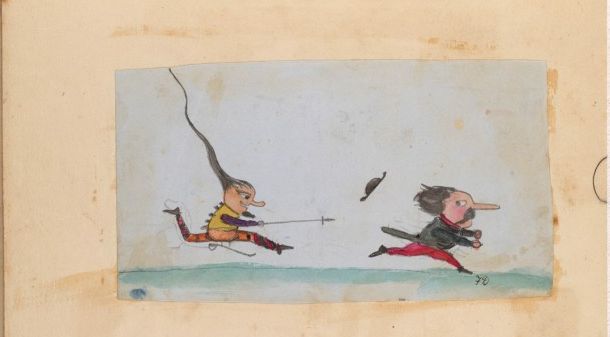The charming doodles Charles Darwin’s children left all over the manuscript of ‘On the Origin of Species’
by Maria Popova
From fish with legs to carrot cavalries, an endearing testament to the human life of science.
In contemplating family, work, and happiness, Charles Darwin proclaimed: “Children are one’s greatest happiness, but often & often a still greater misery. A man of science ought to have none.” And yet he and Emma had ten. Adept at weighing the pros and cons of family life with equal parts earnestness and irreverence, he clearly concluded that the happiness far outweighs the misery.

There is no more endearing a testament to how this balance skews — to both the exuberant happiness that children bring and the benign misery of the innocent waywardness — than the doodles Darwin’s children left on the back-leaves and in the margins of his Origin of Species manuscript draft, recently digitized by the American Museum of Natural History in collaboration with the Cambridge University Library.


At age 8, George Howard Darwin, who grew up to be an astronomer and a mathematician, draws an entire visual taxonomy of the British infantry; Francis Darwin, who followed in his father’s footsteps and became a botanist, draws a warring salad; on a dummy envelope, an unidentified child produces a charming caricature of Darwin himself.





From a fish with legs to a fruit-and-vegetable cavalry, these irrepressibly joyful drawings, some inspired by natural history and some by the typical staples of boyhood fantasy, bespeak the inseparability of science and life — here is one of the greatest scientists of all time, who forever changed humanity’s relationship to itself, and here are the inked imprints of his own life’s most human dimension.




























Many thanks to the wonderful Rebecca Solnit for bringing this treasure to my attention. The children’s drawings are part of AMNH’s ambitious and important Darwin Manuscript Project, which has digitized more than 30,000 of the great scientist’s documents.
For other little-known facets of Darwin’s humanity, see the story of his battle with anxiety, his brilliant strategy for handling critics, and his beautiful letter of appreciation to his best friend and greatest champion, then revisit his contemporary John Ruskin on how drawing helps you see the world more clearly.
Images courtesy of American Museum of Natural History / Cambridge University Library
